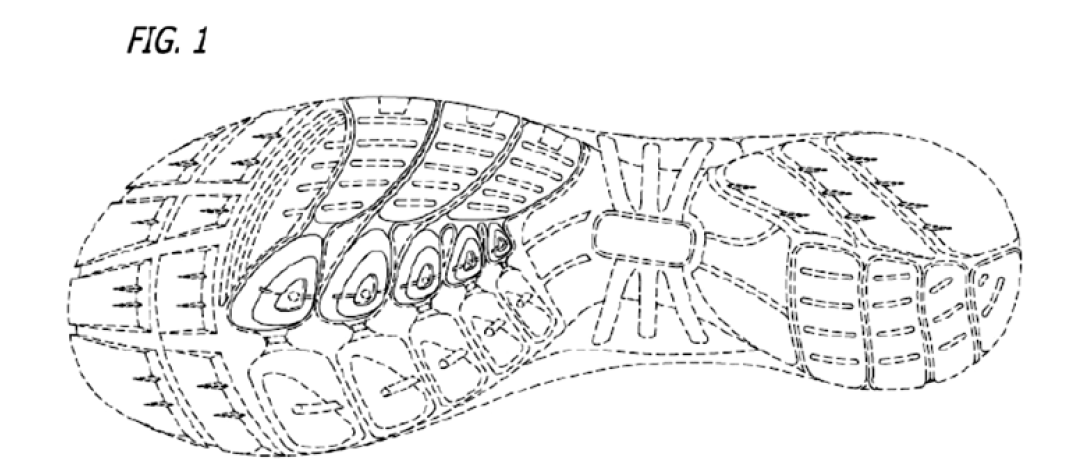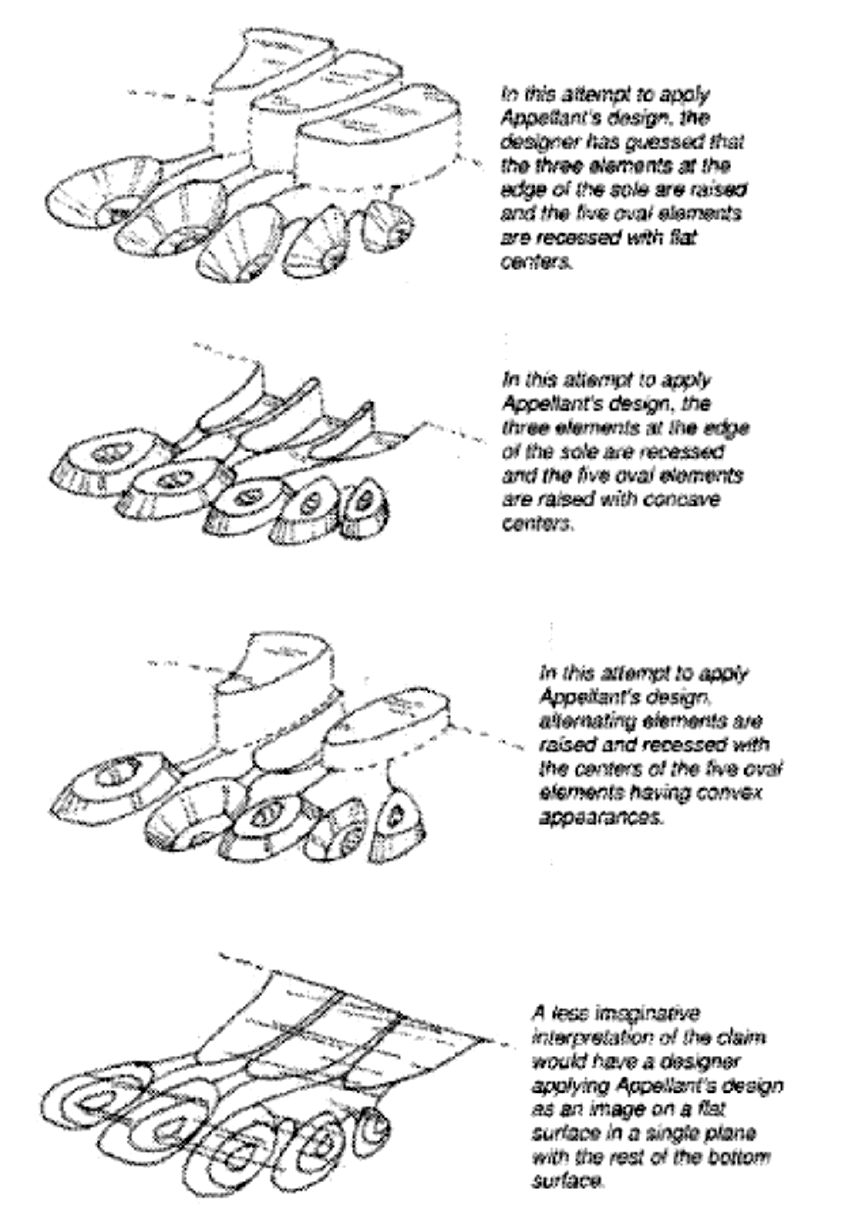【智財評析】設計專利的黃金機會來臨:In re Maatita (Fed. Cir., August 20, 2018)
2018-09-26 劉致宏 專利代理人
針對美國設計專利的明確性與可據以實現性議題,美國聯邦巡迴上訴法院於2018年8月20日在In re Maatita案判決文中做出重要見解,影響美國設計專利的實務甚鉅。本文整理該案內容,並提供相關實務建議供參。
案件背景
Ron Maatita (“Maatita”) 在2011年10月24日提出關於運動鞋鞋底的設計專利申請案,並提供了兩個圖面。其代表圖為圖一,圖中大部分的線是虛線,非設計專利的權利範圍限制,僅有少部分為實線。另一個圖與圖一大部分相同,僅接近足弓的虛線部分不同。也就是說,整個設計專利申請案的圖面,只有代表圖圖一這個平面圖,沒有其他方向的視圖,也沒有立體示意圖。

2014年2月4日審查委員核駁了Maatita的申請案,理由是不符合美國專利法112條第一段與第二段的規定。審查委員認為,用平面圖來表達一個立體的物品,會有多種解釋的方式,因此不符合美國專利法關於明確性與可據以實現性的要求。
針對審查委員的核駁,Maatita在2014年5月1日提出答辯,主張沒有任何理由顯示熟悉該項技藝者會看了圖之後,會無法決定如何實現這個設計,因此沒有可據以實現性的問題。此外,Maatita也認為各種深度與輪廓的設計,都應該被包括在本設計專利的範圍內,因此這是權利範圍廣度的問題,不是明確性的問題。
審查委員在2014年5月13日做出最終核駁。為了反駁Maatita的主張,審查委員準備了四個立體圖面,認為這四個實施方式彼此在專利上為可區分 (patentably distinct)。因此,僅依Maatita的平面圖,熟悉該項技藝者會不確定哪幾個專利上為可區分的實施方式,會落入設計專利的涵蓋範圍,並進而認為Maatita的設計專利申請案不具明確性與可據以實現性。

Maatita不服審查委員的最終核駁,於2014年8月11日上訴到專利審理暨上訴委員會 (Patent Trial and Appeal Board, “PTAB”)。PTAB維持了審查委員的最終核駁。Maatita於是再上訴到聯邦巡迴上訴法院。
上訴法院見解
上訴法院認為,首先,關於設計專利,明確性的判斷與可據以實現性的判斷差別不大。所以,特別在這個案子裡,上訴法院把兩個議題一併討論 (判決文第7頁)。
圖式會不適當到不明確,一種狀況是不同圖式彼此內在不一致 (internally inconsistent)。另一種是圖式跟請求項的文字描述不一致。關於這兩種狀況,法官都引用了多個判決先例加以說明 (詳見判決文第7到8頁) 。
上訴法院認為,本案的狀況不是圖式彼此不一致,也不是圖式跟文字不一致,而是 "單一的設計表達是否會造成範圍不確定。" 關於這點,上訴法院引用了聯邦最高法院在2014年的Nautilus案的觀念,認為關於明確性,美國專利法112條要求專利的請求項在審酌說明書與申請歷史之後,提供熟悉該項技藝者合理確定的範圍 (這個觀念當年被實務界稱為 "合理確定標準 (reasonable certainty standard)"):
In Nautilus, which dealt with indefiniteness in the utility patent context, the Supreme Court emphasized that § 112 ¶ 2 “require[s] that a patent’s claims, viewed in light of the specification and prosecution history, inform those skilled in the art about the scope of the invention with reasonable certainty.” (判決文第9頁)
明確性要求的目的,是確保揭露內容能足夠清楚,告知潛在的競爭者甚麼設計會侵權:
The purpose of § 112’s definiteness requirement, then, is to ensure that the disclosure is clear enough to give potential competitors (who are skilled in the art) notice of what design is claimed—and therefore what would infringe. (判決文第9頁)
基於這個目的,專利的明確性是跟侵權判定的標準連接在一起的。設計專利的侵權判定的觀念
是 "熟悉前案的普通觀察者會被欺騙而認為被控設計與專利的設計相同 (這個觀念被稱為 "普通觀察者測試 (ordinary observer test)")":
A design patent is infringed if “an ordinary observer, familiar with the prior art, would be deceived into thinking that the accused design was the same as the patented design.” Egyptian Goddess, Inc. v. Swisa, Inc., 543 F.3d 665, 672 (Fed. Cir. 2008) (en banc).... (判決文第9頁)
然後重點來了:上訴法院認為基於明確性的目的,推論出設計專利的明確性應該由普通觀察者的觀點評估。所以,設計專利的明確性判斷標準如下:如果普通觀察者不能基於請求項與視覺揭露的內容合理確定設計專利的範圍,那麼該設計專利就基於美國專利法112條不明確:
關於用單一的圖面來表現三維物件的設計是否由會不明確,上訴法院認為,這取決於物件的設計是否能夠被二維的描述定義。某些狀況,比如整雙鞋或整個茶壺的設計,本身就是三維的,從不同視角觀察結果會不同,那麼就不能用二維的描述來定義。另一些狀況,比如地毯或餐墊,就可以用二維的描述來定義 (即使地毯或餐墊的厚度或織法可能不同)。
最後,關於本案的鞋底,上訴法院認為,即使鞋底可能是立體的,很多人也用多個立體圖面申請鞋底的設計專利,這些都無法改變一個事實:鞋底的設計能夠用二維的視圖來揭露跟判斷 (法官還認為Maatita的二維圖式正好證明了這點)。潛在的侵權人不會懷疑怎樣才會侵權。由於設計能夠由圖式中的二維視圖理解,Maatita不揭露所有可能的深度的決定,並不會讓普通觀察者無法了解請求的設計範圍。
The government is correct that a shoe sole is typically three-dimensional, with treads that may be convex or concave. And, indeed, many shoe bottom designers choose to claim their designs in a three dimensional fashion. But the fact that shoe bottoms can have three-dimensional aspects does not change the fact that their ornamental design is capable of being disclosed and judged from a two-dimensional, plan- or planar-view perspective—and that Maatita’s two-dimensional drawing clearly demonstrates the perspective from which the shoe bottom should be viewed. A potential infringer is not left in doubt as to how to determine infringement. In this case, Maatita’s decision not to disclose all possible depth choices would not preclude an ordinary observer from understanding the claimed design, since the design is capable of being understood from the two-dimensional, plan- or planar-view perspective shown in the drawing.
案件背景
Ron Maatita (“Maatita”) 在2011年10月24日提出關於運動鞋鞋底的設計專利申請案,並提供了兩個圖面。其代表圖為圖一,圖中大部分的線是虛線,非設計專利的權利範圍限制,僅有少部分為實線。另一個圖與圖一大部分相同,僅接近足弓的虛線部分不同。也就是說,整個設計專利申請案的圖面,只有代表圖圖一這個平面圖,沒有其他方向的視圖,也沒有立體示意圖。

2014年2月4日審查委員核駁了Maatita的申請案,理由是不符合美國專利法112條第一段與第二段的規定。審查委員認為,用平面圖來表達一個立體的物品,會有多種解釋的方式,因此不符合美國專利法關於明確性與可據以實現性的要求。
針對審查委員的核駁,Maatita在2014年5月1日提出答辯,主張沒有任何理由顯示熟悉該項技藝者會看了圖之後,會無法決定如何實現這個設計,因此沒有可據以實現性的問題。此外,Maatita也認為各種深度與輪廓的設計,都應該被包括在本設計專利的範圍內,因此這是權利範圍廣度的問題,不是明確性的問題。
審查委員在2014年5月13日做出最終核駁。為了反駁Maatita的主張,審查委員準備了四個立體圖面,認為這四個實施方式彼此在專利上為可區分 (patentably distinct)。因此,僅依Maatita的平面圖,熟悉該項技藝者會不確定哪幾個專利上為可區分的實施方式,會落入設計專利的涵蓋範圍,並進而認為Maatita的設計專利申請案不具明確性與可據以實現性。

Maatita不服審查委員的最終核駁,於2014年8月11日上訴到專利審理暨上訴委員會 (Patent Trial and Appeal Board, “PTAB”)。PTAB維持了審查委員的最終核駁。Maatita於是再上訴到聯邦巡迴上訴法院。
上訴法院見解
上訴法院認為,首先,關於設計專利,明確性的判斷與可據以實現性的判斷差別不大。所以,特別在這個案子裡,上訴法院把兩個議題一併討論 (判決文第7頁)。
圖式會不適當到不明確,一種狀況是不同圖式彼此內在不一致 (internally inconsistent)。另一種是圖式跟請求項的文字描述不一致。關於這兩種狀況,法官都引用了多個判決先例加以說明 (詳見判決文第7到8頁) 。
上訴法院認為,本案的狀況不是圖式彼此不一致,也不是圖式跟文字不一致,而是 "單一的設計表達是否會造成範圍不確定。" 關於這點,上訴法院引用了聯邦最高法院在2014年的Nautilus案的觀念,認為關於明確性,美國專利法112條要求專利的請求項在審酌說明書與申請歷史之後,提供熟悉該項技藝者合理確定的範圍 (這個觀念當年被實務界稱為 "合理確定標準 (reasonable certainty standard)"):
In Nautilus, which dealt with indefiniteness in the utility patent context, the Supreme Court emphasized that § 112 ¶ 2 “require[s] that a patent’s claims, viewed in light of the specification and prosecution history, inform those skilled in the art about the scope of the invention with reasonable certainty.” (判決文第9頁)
The purpose of § 112’s definiteness requirement, then, is to ensure that the disclosure is clear enough to give potential competitors (who are skilled in the art) notice of what design is claimed—and therefore what would infringe. (判決文第9頁)
基於這個目的,專利的明確性是跟侵權判定的標準連接在一起的。設計專利的侵權判定的觀念
是 "熟悉前案的普通觀察者會被欺騙而認為被控設計與專利的設計相同 (這個觀念被稱為 "普通觀察者測試 (ordinary observer test)")":
A design patent is infringed if “an ordinary observer, familiar with the prior art, would be deceived into thinking that the accused design was the same as the patented design.” Egyptian Goddess, Inc. v. Swisa, Inc., 543 F.3d 665, 672 (Fed. Cir. 2008) (en banc).... (判決文第9頁)
然後重點來了:上訴法院認為基於明確性的目的,推論出設計專利的明確性應該由普通觀察者的觀點評估。所以,設計專利的明確性判斷標準如下:如果普通觀察者不能基於請求項與視覺揭露的內容合理確定設計專利的範圍,那麼該設計專利就基於美國專利法112條不明確:
Given that the purpose of indefiniteness is to give notice of what would infringe, we believe that in the design patent context, one skilled in the art would assess indefiniteness from the perspective of an ordinary observer. Thus, a design patent is indefinite under § 112 if one skilled in the art, viewing the design as would an ordinary observer, would not understand the scope of the design with reasonable certainty based on the claim and visual disclosure. (判決文第10頁)
關於用單一的圖面來表現三維物件的設計是否由會不明確,上訴法院認為,這取決於物件的設計是否能夠被二維的描述定義。某些狀況,比如整雙鞋或整個茶壺的設計,本身就是三維的,從不同視角觀察結果會不同,那麼就不能用二維的描述來定義。另一些狀況,比如地毯或餐墊,就可以用二維的描述來定義 (即使地毯或餐墊的厚度或織法可能不同)。
最後,關於本案的鞋底,上訴法院認為,即使鞋底可能是立體的,很多人也用多個立體圖面申請鞋底的設計專利,這些都無法改變一個事實:鞋底的設計能夠用二維的視圖來揭露跟判斷 (法官還認為Maatita的二維圖式正好證明了這點)。潛在的侵權人不會懷疑怎樣才會侵權。由於設計能夠由圖式中的二維視圖理解,Maatita不揭露所有可能的深度的決定,並不會讓普通觀察者無法了解請求的設計範圍。
The government is correct that a shoe sole is typically three-dimensional, with treads that may be convex or concave. And, indeed, many shoe bottom designers choose to claim their designs in a three dimensional fashion. But the fact that shoe bottoms can have three-dimensional aspects does not change the fact that their ornamental design is capable of being disclosed and judged from a two-dimensional, plan- or planar-view perspective—and that Maatita’s two-dimensional drawing clearly demonstrates the perspective from which the shoe bottom should be viewed. A potential infringer is not left in doubt as to how to determine infringement. In this case, Maatita’s decision not to disclose all possible depth choices would not preclude an ordinary observer from understanding the claimed design, since the design is capable of being understood from the two-dimensional, plan- or planar-view perspective shown in the drawing.
實務建議
知名美國設計專利律師Perry Saidman認為,本案創造了 "設計專利權人取得較廣保護的黃金時機 (Golden Opportunity for Design Patentees to Obtain Broader Protection)"。由於法院所設定的明確性與可據以實現性的標準是 "普通觀察者是否能判定侵權",大幅降低了明確性與可據以實現性的風險,因此設計專利權人可以開始嘗試用二維視圖來主張三維物品的設計專利權,取得更廣的權利範圍。
Perry Saidman認為這對外國的申請人特別有利,原因是以往美國對於設計專利圖式的明確性與可據以實現性的要求,往往較國外嚴格,造成主張外國設計專利申請案的優先權申請美國設計專利時,會因欠缺明確性與可據以實現性而被核駁。往後這個風險應該會大幅降低。此外,還有一個好處是申請的成本會較低 -- 準備一個二維圖式的成本,會比準備六面圖跟立體示意圖的成本來的低。
往後申請美國設計專利,可以先判斷欲申請的物件設計若採用二維圖式來表現,對於普通觀察者而言是否能夠判斷侵權。若能 (比如地毯、桌墊、鞋底等),那麼可交由專業的美國設計專利申請專家,嘗試用規劃完善的二維圖式提出申請,取得較廣的權利,成本又較低。若不能 (比如茶壺、整雙鞋),那麼就以原本多面視圖的方式提出申請,滿足美國關於明確性與可據以實現性的要求。
知名美國設計專利律師Perry Saidman認為,本案創造了 "設計專利權人取得較廣保護的黃金時機 (Golden Opportunity for Design Patentees to Obtain Broader Protection)"。由於法院所設定的明確性與可據以實現性的標準是 "普通觀察者是否能判定侵權",大幅降低了明確性與可據以實現性的風險,因此設計專利權人可以開始嘗試用二維視圖來主張三維物品的設計專利權,取得更廣的權利範圍。
Perry Saidman認為這對外國的申請人特別有利,原因是以往美國對於設計專利圖式的明確性與可據以實現性的要求,往往較國外嚴格,造成主張外國設計專利申請案的優先權申請美國設計專利時,會因欠缺明確性與可據以實現性而被核駁。往後這個風險應該會大幅降低。此外,還有一個好處是申請的成本會較低 -- 準備一個二維圖式的成本,會比準備六面圖跟立體示意圖的成本來的低。
往後申請美國設計專利,可以先判斷欲申請的物件設計若採用二維圖式來表現,對於普通觀察者而言是否能夠判斷侵權。若能 (比如地毯、桌墊、鞋底等),那麼可交由專業的美國設計專利申請專家,嘗試用規劃完善的二維圖式提出申請,取得較廣的權利,成本又較低。若不能 (比如茶壺、整雙鞋),那麼就以原本多面視圖的方式提出申請,滿足美國關於明確性與可據以實現性的要求。
延伸閱讀:
-
2018-08-23
-
2018-08-22
消息來源:


